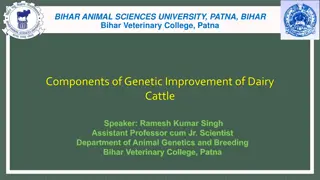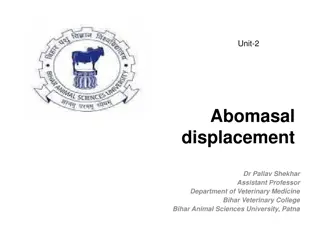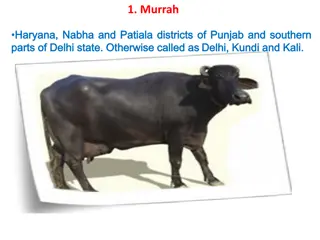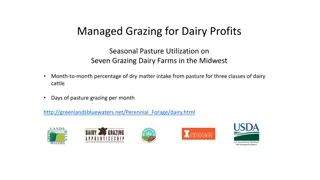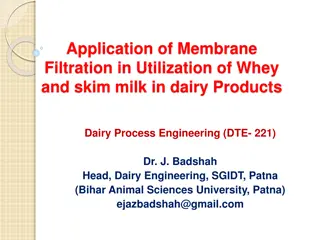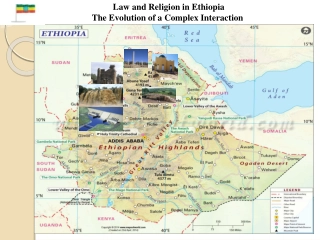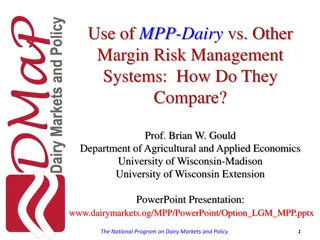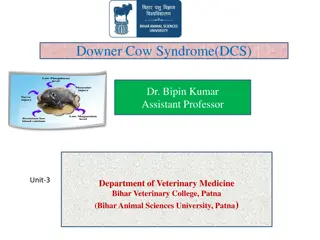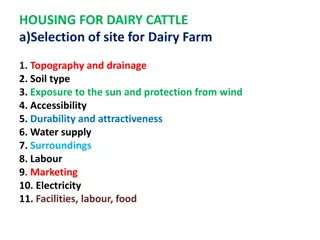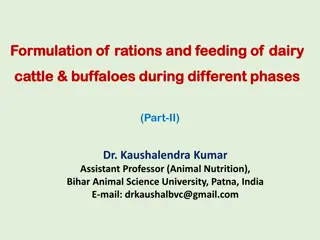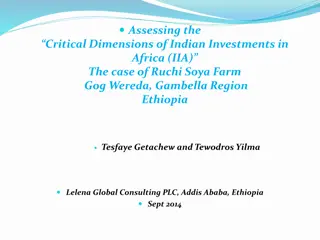Dairy Cattle Production Systems in Ethiopia: Overview and Practices
Ethiopia has a favorable environment for dairy development with diverse production systems including pastoralism, agro-pastoralism, and mixed farming. The country boasts indigenous and exotic dairy cattle breeds, supporting milk production and utilization. This article outlines the different dairy production systems, breeds of dairy cattle, and milk utilization patterns in Ethiopia.
Download Presentation

Please find below an Image/Link to download the presentation.
The content on the website is provided AS IS for your information and personal use only. It may not be sold, licensed, or shared on other websites without obtaining consent from the author. Download presentation by click this link. If you encounter any issues during the download, it is possible that the publisher has removed the file from their server.
E N D
Presentation Transcript
Chapter 4. Dairy Cattle Production Outline 4.1. Dairy Production Systems in Ethiopia 4.2. Breeds of dairy cattle 4.2.1. Indigenous dairy cattle breeds 4.2.1. Exotic dairy cattle breeds 4.3. Milk and milk products utilization pattern 1
Objectives Identify dairy cattle production systems in Ethiopia Describe the different dairy cattle breeds Discuss on milk production and utilization patterns 2
Dairy? Dairy Cattle? Dairy is a farm that produces milk and milk products Dairy cattle: cattle that is raised primarily to produce milk 3
4.1. Dairy Production Systems in Ethiopia Ethiopia holds large potential for dairy development. Country has diverse topographic & climatic conditions favorable for dairying. Moreover, rainfall in most of the country is adequate for crop & pasture production. The favorable climate throughout the country supports use of improved, high-yielding animal breeds and offers a relatively disease-free environment for livestock development. 4
It is raised in all of the farming systems by pastoralists, agro- pastoralists & crop-livestock farmers. Ethiopian milk production systems can be broadly categorized based on location market orientation, scale, and production intensity Accordingly, 5 dairy production systems are distinguished 5
1. Pastoralism livestock owners who exploit natural grass lands mainly in the arid areas Pastoralists are with their herds always and move continually looking for fresh grazing areas. Nomads have no permanent home while transhumant herders have permanent homes in less arid areas. The main source of food for pastoralists is milk the herd is dominated with unimproved Zebu animals milk production is of subsistent type 6
2. Agro-pastoralism Agro-pastoralists are sedentary farmers who grow food crops and also keep livestock. Their livestock graze on common land, fallow lands and cropland after they harvest. Livestock are used for drought savings and milk production. Shifting cultivation is a common practice. the herd is dominated with unimproved Zebu animals milk production is of subsistent type 7
3. Mixed farming Food or cash crop cultivation is the main agricultural activity. Farm size is normally small 1-5 ha, with a moderate to high cropping intensity. maintenance of soil fertility is one of the main problems of livestock livestock are kept for consuming of crop residues, improving soil fertility and providing additional food or income from milk or meat the herd is dominated with unimproved Zebu animals milk production is of subsistent type 8
4. Urban and Per-Urban Milk Production This system occurs around cities, where demand for milk is high. The main source of feed are agro-industrial by- products (e.g. brewery waste & oilseed cake), cultivated fodder crops and crop residues The system comprise small & medium size dairy farms located mainly in the high lands of Ethiopia. Milk is often sold directly to consumers in the city and is the main source of income for the farmers . the herd is dominated with improved crossbred and high-grade dairy cattle 9
5. Intensive dairy farming It is a more specialized dairy farming practiced by state sector and very few individuals on commercial bases. Most of the intensive dairy farms are concentrated in & around Addis Ababa and are basically based on exotic purebred stock. This system produces about 2% of the total milk production of the country. milk is the main source of farm income it is mainly undertaken by small farmers using family labor, but commercial farmers using hired labor the herd is dominated with improved crossbred dairy cattle the production system is market oriented and milk production is for sale (surplus production) 10
4.2. Breeds of Dairy Cattle Dairy farming has been part of agriculture for thousands of years, but usually done on a small scale on mixed farms. There was little distinction between dairy and beef cattle, with the same stock often being used for both meat & milk production. Today, dairy cows are specialized and most have been bred to produce large volumes of milk, with little or no regard for their production of meat. Dairy cattle are breeds of cattle raised for their ability to produce large quantities of milk 11
Most of the cattle breed in the tropics are evolved through natural selection Most indigenous cattle breeds in the tropics are multipurpose (milk, meat, draught) and that only a few breeds have good milk potential. 4.2.1 Indigenous Dairy Cattle Breeds The maintenance of farm animal genetic diversity is of crucial importance to food production, food security and the sustainability of farming systems. 12
Indigenous livestock breeds are important because, they are adapted to local conditions and farming systems tolerate seasonal variations in climate & forage supply, and resist local diseases and parasites. Indigenous livestock breeds provide an invaluable reservoir of genetic variation and breeding potential for adaptation to changing climatic and farming conditions 13
No interference has been made by man except few attempts tried in few research sites. They are not well characterized. Thus, they are called with references to the place where they dominate. Example: Begait (dominating northern part of the country around Tigray), Boran (Dominating southern part of the country around Borena), Fogera (Northern part of the country around Fogera). In general, indigenous cattle are multipurpose in their function. i.e. meat, milk and draft. 14
1. Begait/Barca Found in Tigray and west Eritrea. It is a tall animal with long legs The coat color is variable but black pied is common. Hump is very large in male and often falls to one side. The head is small and short. The cattle have good milk yield and They can be genetically improved for milk production. 15
2. Fogera Found around Lake Tana in Gondar and Gojam. are large sized being tall animal with long leg. have black & white or black & gray coat. Muzzle & hoofs are almost always black. The horns and hump are very small and the animal is docile. Currently are used as meat, milk and draught animals; potentially they are good in milk production and can be improved genetically for the trait 16
3.Borana originated from Borana area of south Ethiopia. At present these breeds are found in Somalia and Kenya. They are fairly large and long- legged animals with good body conformation. They are whitish-grey in color; the male has black color on their hump The hump is very well developed in the male and smaller in females. 17
3.Borana cont. Horns are usually small, thick at the base, pointed and directed forward. Have huge body conformation and thick skin, drought and pest resistant and ability to travel long distance. 18
3.Borana cont. Utility: the breed is used by semi-nomadic people primarily for milk and if selected for milk Borana cows are moderately good milker. Currently, the breed is used for milk production especially in crossbreeding programs. 19
4. Sheko breed Found in south western Ethiopian, Short horned or polled hump less/very small humps Known with resistant to trypanosomiasis have well shaped udder and are kept mainly for their milk. 20
4.2.2. Exotic Dairy Cattle Breeds Most temperate breeds are artificially selected for productive traits and they are improved breeds for either beef or dairy production Major exotic breeds of dairy cattle include i. Holstein Friesian (HF) originated in Holland. Characterized by its color (shiny black &white), large size and exceptional milk production. A mature cow annually produces an average of 8000 kg of 3.7% butterfat, 3.2% protein milk. mature cow weigh, up to 750 kg 21
They rank 1st in their milk production and rank 5th in their milk fat content (3.7%). They are poor grazers, they need intensive feeding, and they produce more in cool regions. 2. Jersey Are originated in the island of Jersey in UK are the smallest dairy breed, with yellowish-brown or fawn in color. They have a strong udder attachment 23
their milk production (4536 kg /lactation), 1ts in their milk fat content (5.4%), Jersey produces more kg of milk per kg of body weight than any other breed are relatively good grazers and good in feed conversion efficiency and can produce well in tropics 24
3. Guernsey Originated in Guernsey Island, in UK are Yellowish-Brown or Fawn in color. Their milk is especially yellow in color: their milk production (4808kg/ lactation) 2nd in their milk fat content (5%) 25
4.Brown Swiss Originated in Switzerland, Are solid brown in color. They are larger breeds, & relatively heat tolerant. milk lactation) their milk fat content (5%). production (5488kg/ 26
5. Ayrshire originated in Scotland red and white in color They have well developed udder and excellent grazing ability. milk production (5307kg/lactation) their milk fat content (4%). 27
4.3. Milk and Milk products Utilization patterns Milk A white fluid secreted by the mammary glands of female mammals for the primary function of meeting the complete nutritional requirements of the calf Nature sMost Perfect Food (is a highly nutritious food, but it is also an excellent growth medium for bacteria. Raw milk has the potential to transfer zoonotic diseases so milk handling procedures must minimize associated health risks 28
Milk is mainly comprised of water (79-90% ), followed by lactose, fat, protein, and minerals; and minor constituents are enzymes and vitamins The composition of milk determines its nutritive value and influences the quality of dairy products manufactured from it. 29
Properties of Milk The major properties of milk are Color Normal milk has an opalescent white (shine with wavering light) to yellow color. Specific gravity Milk contains many constituents whose specific gravity is greater than that of water. Therefore milk is heavier than water iii. Freezing point Pure water freezes at 00c. While, milk freezes at -0.550c. an increase in freezing point indicates the presence of added water in the milk. i. ii. 30
iv. Boiling point Water boils at 1000c (2120F) while milk boils at 100.170C (212.30F) These are influenced by the composition of milk. They have also great advantage in the processing and testing of milk for adulteration/quality. 31
Dairy products Dairy products. Those products derived from milk 1. Fluid Milk/whole milk 2. skim milk-To reduce the fat content of milk, creamy layer is trimmed down) / 3. Butter: - of all the products made from milk, butter is probably the most universally used and liked. Typical butter contains about 82% fat. It is used extensively in cooking and baking. 4. Cheese: - it is generally made from whole milk, but is may be also made from skimmed milk and cream. A typical composition of whole- milk cheese would be 30% fat, 24% protein compounds, 2% salt and 40 % water. 32
5. Butter 6. Yogurt-fermented milk 7. Powdered Milk 8. Ghee (clarified butter) 9. Whey: - it is highest in water content of all the milk by products 33
4.3. Milk and Milk products Utilization patterns Most farmers use their own milk for different purpose include Home consumption in fresh form and fermented ( Igro) Processing long shelf life products (butter and cheese) Saving in liquid form Calf feeding However, level of utilization pattern varies depending upon The production systems proximity to urban centers /towns, availability of market outlets Seasons and Economic factors (price). 34
Species comparison in milk composition Species Total solids Fat Protein Lactose Ash Human Cow Goat Sheep 12.2 12.7 12.3 19.3 3.8 3.7 4.5 7.4 1.0 3.4 2.9 4.5 7.0 4.8 4.1 4.8 0.2 0.7 0.8 1.0 35
Advantage of Dairy Dairy cattle use roughage feeds the otherwise would be wasted. Dairying provides a steady (stable) income throughout the year. Labor is used throughout the year. Death rate is usually low if good management is followed. Disadvantages of dairy rising A high capital investment is needed. The labor requirement is high and the operators are confined to a regular schedule of milking. training and experiences are needed before entering into the dairy business it takes relatively longer time to produce a high producing dairy herd 36
Assignment: Success and failures of the livestock extension system (Breed improvement, Feed, Technology, Veterinary Service, Artificial Insemination, Market and etc ) in Ethiopia 37



